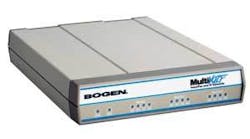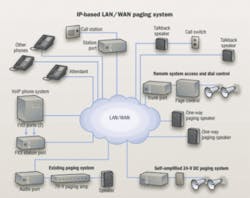Evaluating the economics of VoIP paging systems
By Betsy Ziobron
As traditional paging systems face the IP revolution, vendors weigh in on financial and performance considerations.
Traditional analog paging and alert systems, like many other facets of security, are facing the Internet Protocol (IP) revolution. As Voice over IP (VoIP) adoption rates continue to increase, in-building as well as outside paging/alert systems have to accommodate IP voice lines, and almost every vendor of paging systems now offers VoIP paging products. But while IP-based paging systems have become a cost-effective means of paging to other locations, economically they do not always make sense once inside the building.
An earlier article in this publication (“Paging systems alert: New features bound,” December 2006, p. 31) discussed the still-popular traditional analog systems on the market. This month’s article takes a look at the transition of paging and alert systems from analog to digital, and some of the VoIP paging products hitting the market.
Evaluating economics
“When it comes to paging, VoIP is a very interesting area that has the potential to provide enhanced capabilities to customers,” says Dave Chambers, senior vice president of sales for Bogen Communications (www.bogen.com). “If you want to connect a traditional paging system from one building to the next, trenching or running overhead wires is very expensive. If you transition the analog signal to digital and send it to the other building over the existing LAN, it could mean huge savings.”
While VoIP paging and alert systems are trendy among high-tech companies, once the digital signal reaches the other building, it may not yet be economical to deploy a full IP-based paging system with VoIP speakers.
“The price of IP speakers is more than 10 times the cost of a traditional speaker, so they’re not even close to being economical,” says Chambers. “When it comes to VoIP telephony, there is a long-term savings gained by eliminating the cost of toll calls. With paging, there is no subsequent cost after the initial installation and no long-term savings.”
To avoid the high cost of IP speakers, most vendors recommend you use an adapter or gateway. Adapters convert analog voice to digital at one location, and once the voice signal travels over the LAN or WAN to another location, a second adapter converts the digital signal back to analog where traditional speakers are used.
“The drive for VoIP speakers comes from those high-tech customers that want to claim they have the technology,” says Tom Hoover, program manager for VoIP products at Valcom (www.valcom.com), “but there is misunderstanding of that technology. Where we find VoIP to benefit the paging world is when the customer has to page longer distances from building to building, or between floors in a building. But even in that scenario, it makes sense to go from adapter to adapter and then use traditional analog speakers in a given zone or area.”
G. Christopher Coffin, chief executive officer and co-founder of Digital Acoustics (www.digitalacoustics.com) notes that, in reality, there are no IP speakers: “All speakers are analog devices. Vendors put an IP amplifier and interface device in front of the speaker, and then call it an IP speaker. Depending on the environment, you may want to use a variety of speakers-round, wall-mount, drop-in ceiling speakers, horns, etc. We believe it makes more sense to connect an IP amplifier to multiple different speakers to meet the needs of the application. This makes sense in multi-zone applications that require a lot of flexibility.”
VoIP offerings
Bogen offers VoIP gateways, but chooses not to offer VoIP speakers. “While it might make sense to add one or two VoIP speakers in special situations, we don’t think it’s worth offering those speakers at this time,” says Chambers. “When they get down to $50 or $100, there may be more justification.”
Bogen’s VoIP gateways for paging are available in 1-, 2-, 4-, and 8-port versions for simultaneously paging to multiple zones. For example, the 8-port VoIP gateway can connect via an existing Ethernet network to eight gateways located at eight remote locations or zones. Bogen’s gateway is configurable via a Web browser or Microsoft Windows, and it can connect directly to an existing phone or PBX system.
“We find it very advantageous to use the VoIP gateway with the traditional system behind it,” says Chambers.
Valcom offers 1-, 2-, 3-, and 4-channel VoIP adapters, as well as one-way and talkback VoIP speakers. Also configured with Windows-based setup, Valcom’s managed VIP-804 Quad Networked Page Zone Extender (shown above) has four audio outputs and inputs to enable voice access to four zones of one-way paging over an IP-based LAN/WAN. The company also offers adapters that connect to an analog PBX port to convert analog signals to digital. Valcom says it plans to introduce a purely digital paging device that will have network-to-network connectivity via Ethernet switches.
“Our VoIP adapters allow customers to connect zones of paging or single-line telephones to page miles away to another location,” says Hoover. “Through multicasting, we can deploy adapters in several locations across the country and either page to all locations, one location, or some locations.”
Multicasting enables communications with a select group of zones while unicasting is direct communication between a single sender and single receiver. According to Hoover, multicasting requires much less bandwidth than unicasting, which increases bandwidth use for each additional page zone.
“The only limitation to VoIP paging is the size and speed of the network,” he says. “A multicast page only takes up 76 kbits/sec of bandwidth and remains constant. With unicast, every time you page to another zone, it increased the bandwidth by another 76 kbits/sec.”
Valcom offers one of the lowest-priced VoIP speakers at $350, and the company is working to further reduce prices to make VoIP speakers more economical. “If you just need one speaker, our VoIP speakers make sense, especially since they are the least expensive VoIP speakers available,” says Hoover. “Often, customers may just need one speaker at an outside location, but outside applications typically require a horn. VoIP horns are not currently available, but customers can look for a VoIP from Valcom this year.”
Digital Acoustics’ new ii3 Series IP paging system takes a different approach. The system’s core component is the ii3-ESS IP Audio Amplifier, which can drive single or multiple 8-Ω speakers. “Our IP amplifier can be connected to any analog 8-Ω speaker,” says Coffin. “It can be as simple as one-to-one, or the customer can use one amplifier for up to eight speakers, depending on the amplification power required for the specific environment. Instead of the cost of four or five expensive IP speakers, customers can implement one of our IP amplifiers to create an IP zone of several analog speakers.”
The ii3-ESS IP Audio Amplifier has a maximum output of 20 watts with an external power supply, or for low-output applications of less than 8 watts, the amplifier can use Power over Ethernet. The system is also available with the TalkMaster Enterprise Edition, a server-based solution designed to manage thousands of intercom and paging end points distributed over an IP network. “Our philosophy is that there isn’t one solution for everybody,” says Coffin. “With our system, we provide the building blocks to craft a solution that works for your specific environment.”
Forecasting the future
Paging to multiple locations has not always been an option with the high cost of trenching or leased lines. But with today’s heightened security concerns and the reduced costs associated with consolidating operations, customers can now take advantage of VoIP to page to multiple locations.
“It’s not so much that things have changed-it’s that the means, flexibility, and cost to deploy a paging system that support a multibuilding organization is now available,” says Coffin. “Everybody is considering their operations rather than having each site manage their own systems, and VoIP paging is ideal for that situation.”
While a pure IP paging system with VoIP speakers may not yet be economical in most scenarios, the demand is growing. “If telephony providers don’t try to sell VoIP, they’d have nothing to sell because traditional paging systems work fine and last a long time,” says Chambers. “I believe that many are pushing VoIP because they feel it is hypocritical to sell VoIP telephony and then tell their customers that it makes more sense to use traditional paging speakers.”
With cost as the biggest obstacle, many do not foresee paging and alert systems shifting exclusively to VoIP over the next 5 to 10 years, as will likely be the case with telephony.
“We’ll find VoIP paging in office areas, but in the industrial warehouse applications or larger plants, I believe many will stick with analog speakers because they just won’t do that type of high-powered paging with VoIP,” says Hoover. “There are still a lot of mom-and-pop businesses that will just need to page to a back room.”BETSY ZIOBRON is a freelance writer and frequent contributor to Cabling Installation & Maintenance. She can be reached at: [email protected]



